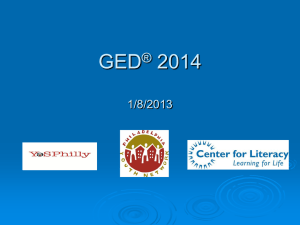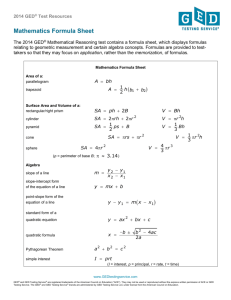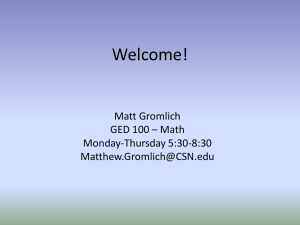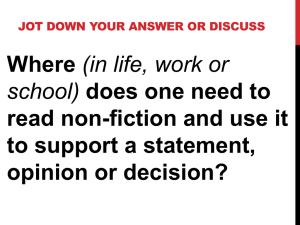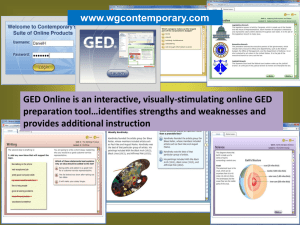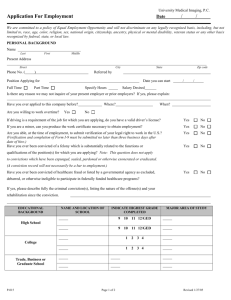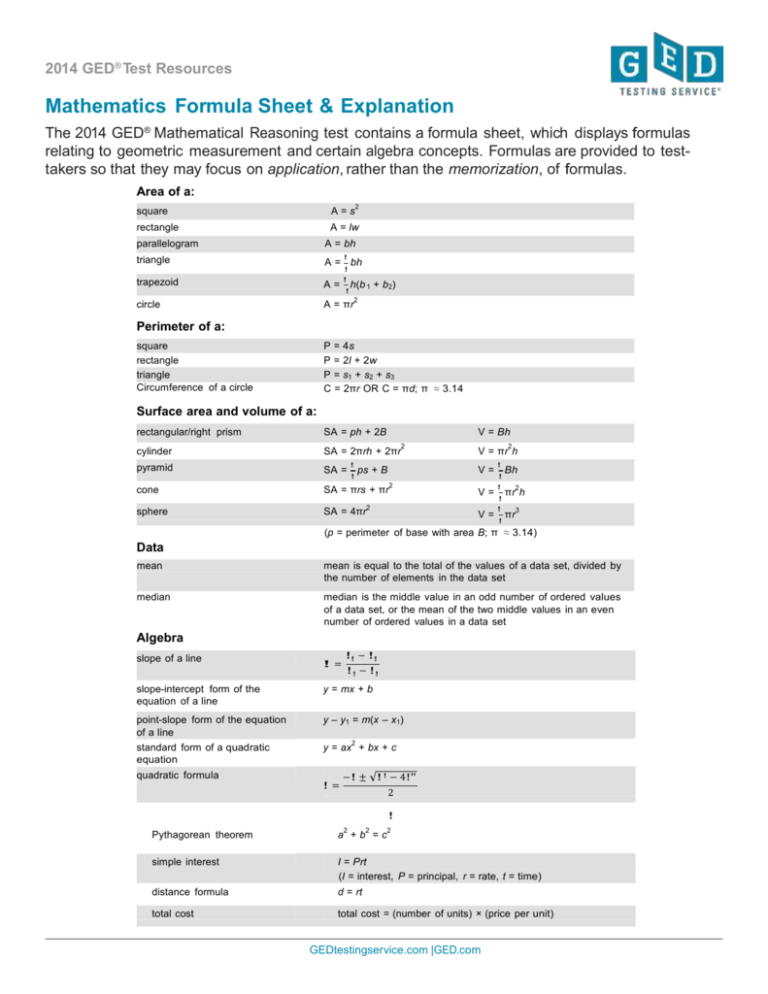
2014 GED® Test Resources
Mathematics Formula Sheet & Explanation
The 2014 GED® Mathematical Reasoning test contains a formula sheet, which displays formulas
relating to geometric measurement and certain algebra concepts. Formulas are provided to testtakers so that they may focus on application, rather than the memorization, of formulas.
Area of a:
square
A=s
rectangle
2
A = lw
parallelogram
A = bh
triangle
A = bh
trapezoid
A=
!
!
!
!
h(b 1 + b2)
2
A = πr
circle
Perimeter of a:
square
rectangle
triangle
Circumference of a circle
P = 4s
P = 2l + 2w
P = s1 + s2 + s3
C = 2πr OR C = πd; π ≈ 3.14
Surface area and volume of a:
rectangular/right prism
SA = ph + 2B
V = Bh
2
cylinder
SA = 2πrh + 2πr
pyramid
SA =
cone
sphere
!
!
ps + B
2
V = πr h
V=
2
SA = πrs + πr
SA = 4πr2
V=
V=
!
!
!
!
!
!
Bh
2
πr h
πr
3
(p = perimeter of base with area B; π ≈ 3.14)
Data
mean
mean is equal to the total of the values of a data set, divided by
the number of elements in the data set
median
median is the middle value in an odd number of ordered values
of a data set, or the mean of the two middle values in an even
number of ordered values in a data set
Algebra
!! − !!
!! − !!
slope of a line
!=
slope-intercept form of the
equation of a line
y = mx + b
point-slope form of the equation
of a line
y – y1 = m(x – x1)
standard form of a quadratic
equation
y = ax + bx + c
2
quadratic formula
!=
−! ± ! ! − 4!"
2
!
2
2
2
Pythagorean theorem
a +b =c
simple interest
I = Prt
(I = interest, P = principal, r = rate, t = time)
distance formula
d = rt
total cost
total cost = (number of units) × (price per unit)
GEDtestingservice.com |GED.com
Top Skills 2014 Test-takers are Missing:
Analysis based on the most missed items from the
2014 GED® test (released August 2014)
This resource highlights the skills that test-takers must demonstrate in order to correctly answer the most
®
commonly missed questions on the 2014 GED test. We strongly recommend working with test-takers on
these skills to help them prepare for the test. In general, test-takers who are able to demonstrate these skills
will score higher in each test subject.
Reasoning Through Language Arts
Indicator
*
Code
R.2.1
R.2.5
R.2.6
R.3.3
Skill/Description
Understand specific details and main ideas in a written source.
Determine which details support the main idea.
Identify a theme or element of a written source that supports a theme.
Analyze relationships within written sources.
Science
Indicator
Code*
SC.3.a
SC.6.c
SC.7.a
Skill/Description
Pull specific evidence from a written source to support a finding or conclusion.
Express scientific information or findings in words.
Understand and apply scientific models, theories, and processes.
Social Studies
Indicator
Code*
SSP.1.a
SSP.2.b
SSp.3.c
Skill/Description
Determine the clearly stated details in primary and secondary sources, and use this information to
make logical inferences or valid claims.
Describe people, places, environments, processes, and events, and the connections between and
among them.
Analyze cause-and-effect relationships, including those with multiple factors.
Mathematical Reasoning
Quantitative Reasoning
Indicator
Code*
Q.4.b
Q.4.c
Q.4.d
Skill/Description
Compute the area and circumference of circles. Find the radius or diameter of a circle when given
the area or circumference.
Compute the perimeter and area of polygons. Find side lengths of a polygon when given the
perimeter or area.
Compute the perimeter and area of two-dimensional composite shapes, which could include circles.
GED® and GED Testing Service® are registered trademarks of the American Council on Education. They may not be used or reproduced without the express writte n permission of ACE or
GED Testing Service. The GED® and GED Testing Service® brands are administered by GED Testing Service LLC under license from the American Council on Education.
Copyright © 2014 GED Testing Service LLC. All rights reserved.
Algebraic Reasoning
Indicator
Code*
A.5.a
A.5.b
A.5.d
Skill/Description
Locate points in the coordinate plane.
Determine the slope of a line from a graph, equation, or table.
Graph two-variable linear equations.
Quantitative Reasoning
Indicator
Code*
Q.3.b
Q.3.d
Skill/Description
Use scale factors to determine the magnitude of a size change. Convert between actual drawings
and scale drawings.
Solve two-step, arithmetic, real world problems involving percents. Examples include but are not
limited to: simple interest, tax, markups and markdowns, gratuities and commissions, percent
increase and decrease.
Mathematical Practice and Content Interaction (search for and recognize entry points for
solving a problem) and Algebraic Reasoning
Indicator
Code*
A.2.a
A.3.a
A.4.a
Skill/Description
Solve one-variable linear equations, and formulas with multiple variables.
Solve linear inequalities in one variable.
Solve one-variable quadratic equations with real solutions, using any appropriate method.
Mathematical Practice and Content Interaction (create algebraic models that represent realworld situations) and Algebraic Reasoning
Indicator
Code*
A.1.c
A.2.c
A.3.d
Skill/Description
Create linear expressions as part of word-to-symbol translations or to represent situations you have
been given.
Create one- or two-variable linear equations to represent situations you have been given.
Create one-variable linear inequalities to represent situations you have been given.
To identify these skills, GED Testing Service:
®
Examined the performance of test-takers who earned the GED Passing Score for High School Equivalency in the
test subject
Examined the performance of test-takers who didn’t pass the test subject
Found the most common questions that test-takers who passed answered correctly, but test-takers who
didn’t pass answered incorrectly
Identified the skills needed to answer those most missed questions
®
This analysis is based on test-taker performance on the 2014 GED test from January-June 2014.
*
“Indicator Code” refers to the GED® test indicator numbering found in Chapter 2 of the Assessment Guide for Educators.
GEDtestingservice.com • GED.com
Helpful Hints for Word Problems
A word problem is a sentence or group of sentences that tell a story, contains numbers and asks the reader
to find another number.
Steps in Solving Word Problems:
1. Decide what the question is asking you to find.
2. Then, decide what information is necessary in order to solve the
problem.
3. Next, decide what arithmetic operation to use.
4. Work out the problem and find the solution. Check your arithmetic.
5. Reread the question to make sure that your answer is sensible.
Addition Key Words (Please add words to these lists!):
sum
plus
add
and
both
total
more
raise
extra
in all
increase
combined
altogether
additional
Subtraction Key Words:
less than
more than
nearer
decrease
remain
dropped
difference
reduce
change
farther ----other –er comparison words
left
fell
lost
Sometime the same key word that helped you decide to add in one word problem can appear in a problem
that requires subtraction. Be sure to read the question, find out what is being asked for.
Multiplication Key Words:
twice
times
total
multiplied
as much
volume
of
by
per
area
In multiplication word problems, you are given 1 of something and asked to find many.
Division Key Words:
split
each
cut
ratio
every
shared
divided (evenly)
equal pieces
out of
average
In division word problems, you are given many things and asked to find one.
Adapted from P. Edwards
How to Teach Math Anxiety
1. Always call on a student first then, without pausing, ask a question.
2. Avoid any reference to practical applications and stress the abstract nature of mathematics.
3. When correcting papers, give credit only to correct answers. Avoid partial credit at all costs.
4. Always insist on students using the correct method.
5. Make all tests sufficiently difficult and lengthy so that only the very swift finish.
6. When going over homework, never reveal any of the difficulties you had solving the problem the
night before.
7. Never let students use their notes. They aren’t going to be allowed to use notes in the “real
world” are they?
8. Always stress competition. Never, never let them work together.
9. Always speak in the abstract and use lots of symbols. Never, never use manipulatives.
10. It’s the little things that are important. Always pepper your lecture with little sayings to increase
math anxiety like:
Be quiet!
Listen to me!
Oh, that’s easy
I already explained that!
I’ll test you on this!
Oh, that’s obvious
That’s a stupid question
You see how it’s done, don’t you?
Who doesn’t get it?
You should know that
Good students can do this in their heads
This is very simple. Watch!
You did it the wrong way.
Some students have a math mind, some don’t
From YouTube: Michael Serra at CMC-North Ignite
Math Anxiety Bill of Rights
By Sandra L. Davis
Emotions
I have the right to learn at my own pace and not feel put down or stupid if
I’m slower than someone else.
I have the right to feel good about myself regardless of my abilities in math.
I have the right to relax.
I have the right not to base my self-worth on my math skills.
I have the right to dislike math.
Learning approaches
I have the right to ask whatever questions I have.
I have the right to need extra help.
I have the right to ask a teacher or tutor for help.
I have the right to say I don’t understand.
I have the right to not understand.
Self-worth
I have the right to view myself as capable of learning math.
I have the right to be treated as a competent person.
I have the right to define success in my own terms.
Evaluation works both ways
I have the right to evaluate my math instructors and how they teach.

